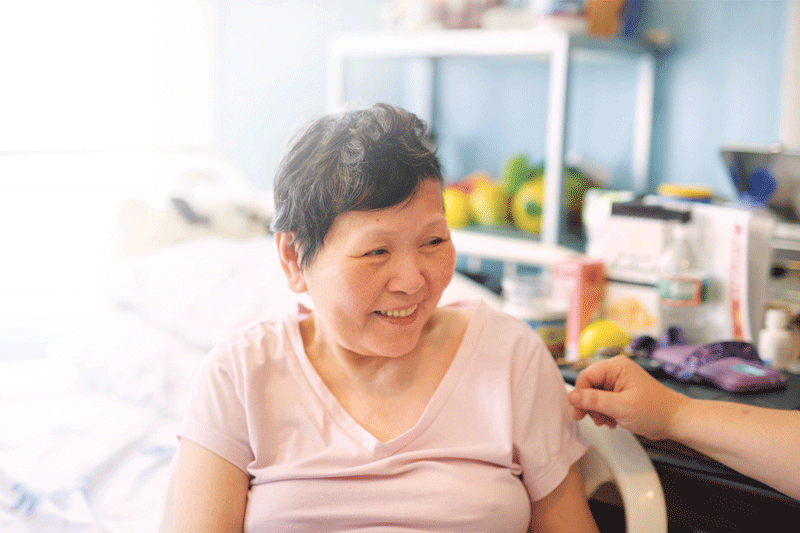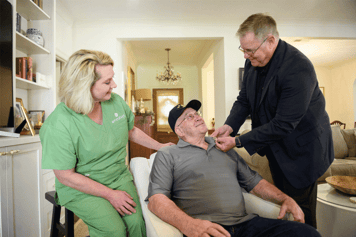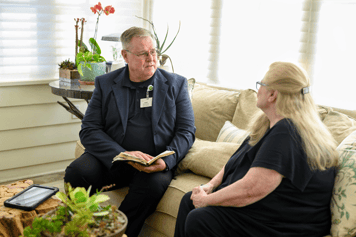For patients on hospice care, volunteers play an essential role. Whether they’re simply being present with a patient or helping behind the scenes, volunteers help create trusting bonds and meaningful memories for hospice patients and their loved ones. Just as volunteers are important to hospice patients, hospice patients make service work rewarding for volunteers.
What Do Hospice Care Volunteers Do?
Hospice volunteers provide comfort, compassion and care for people as they near the end of life. There are many ways they can do this. Some of the roles hospice volunteers fill include:
[action 1]
Direct Patient Interaction
These hospice volunteers interact directly with patients. They travel to the patient’s home, nursing home or long-term care facility and help by:
- Spending time and being present with the patient
- Reading or playing soothing music
- Playing games like cards or board games
- Writing legacy letters with the patient
- Cooking meals
- Doing light household chores
- Providing respite so family caregivers can take a break
- Drawing on special skills such as providing haircuts or manicures, playing an instrument or creating art projects
Indirect Patient Interaction
Hospice volunteers can make a difference without providing direct patient assistance. For example, they can make blankets or handmade cards that get delivered to patients. They can also advocate for hospice patients in the community or go to volunteer health fairs.
Bereavement
Hospice volunteers can work with the agency’s bereavement coordinator to provide support for loved ones. This may include:
- Making phone calls
- Assisting with annual remembrance events
- Helping with grief and loss support groups
- Following up with bereaved family members
Administrative
Some hospice care volunteers prefer to dedicate their time behind the scenes. They can help with:
- Preparing mailings or letters
- Filing, data entry, photocopying or other clerical duties
- Answering phone calls
- Helping set up community events
- Calling patients’ homes to provide extra comfort and support
Why Become a Hospice Volunteer?
The work can be emotional, but hospice care volunteers make a real impact. Research shows that programs with more volunteer involvement report higher levels of patient satisfaction.
Some people feel “called” to hospice by a previous experience. They may have witnessed the compassionate support hospice gave a loved one and want to provide the same comfort to someone else. Others volunteer because they want to give back, meet new people or make their community a better place. Young people may volunteer to build their college application or work resume.
Research shows volunteering has several benefits, including:
- Better mental and physical health
- More life satisfaction
- Higher self-esteem
- Fewer symptoms of depression
- Increased life expectancy
- Improved sense of well-being
“When people volunteer at a hospice program, they usually don’t expect to gain anything,” says Katherine Barham, a volunteer coordinator at the Amedisys hospice care center in Garner, NC. “But what they find is that they get back so much more than they could’ve imagined.” Working with people near the end of their lives gives many hospice volunteers an appreciation for life, a sense of fulfillment and an understanding of what really matters.
Robin Hood, a hospice volunteer in South Portland, ME, says “Almost all that I do for my hospice friends becomes reciprocal. When I can bring them comfort and joy, there is no better reward.” When speaking to a group of new volunteers, Hood explained, “You fall in love every day. And you learn something new every visit.”
Volunteers bond with patients on a personal level. This connection is special to the volunteer and the patient. It also provides helpful insights to the rest of the hospice care team about how best to care for the patient.
“Once you give your time, you’ll be repaid abundantly many times over in blessings,” says Helene Horgan, a volunteer coordinator at the Amedisys hospice care center in Cartersville, GA. She fondly recalls her first patient visit. The patient, a nonverbal gentleman, was lying in bed and when she walked in the room, “his eyes lit up,” she says. “He knew I was there just for him.” She talked with him about items in the room and set his cat on the bed next to him. She reached out to take his hand and, looking at the bracelets she had on, the patient said, “pretty.”
“I will always remember it,” she adds. “My heart and chest felt like a huge balloon. I felt elated that because of me, he smiled and spoke a word. It’s a wonderful feeling. We get to spend time with the most amazing people.”
Characteristics of a Hospice Volunteer
Every hospice care volunteer brings unique talents and perspectives. The volunteer coordinator gets to know the volunteer on a personal level and does their best to match the volunteer’s skills and preferences to the patient’s needs and interests. “Being a hospice volunteer is a commitment like no other,” says Barham. “People who do this truly have a heart for it.”
Some common traits Barham looks for in a hospice volunteer include:
- Compassionate
- Empathetic
- Desire to give back and serve others
- Strong listener
- Comfortable with silence
- Respect for different beliefs and ways of life
“You never know who will walk through your door and make a connection,” says Barham, remembering a 17-year-old young man who volunteered (with supervision) to help a hospice patient at an assisted living facility. At his first meeting with his hospice patient, she beamed, “You’ll be visiting me? You are so handsome. What will we do?” He got down on his knees at eye level and replied, “I don’t know, but we’ll figure it out.” “It was a special moment,” Barham says. “Those interactions are why we do this work.”
How to Become a Hospice Care Volunteer
One way to get started as a hospice volunteer is to contact your local hospice agency or complete this form. You can also look at The National Hospice and Palliative Care Organization’s free hospice locator. Another option is to check a website that connects people with volunteer opportunities such as VolunteerMatch.org.
The hospice volunteer coordinator can walk you through the agency’s needs and find a role that matches your interests. You’ll fill out an application and do a brief interview about your availability and preferences. Volunteers can give as much or as little of their time as they like and choose their own hours.
Before getting to work, hospice volunteers typically complete a background check and tuberculosis test (paid for by the hospice agency) and provide references. They also receive thorough training that typically covers:
- What hospice is and what services it provides
- Typical end-of-life needs
- Ways to communicate with patients and caregivers
- Setting healthy boundaries
- Grief and loss
- Health care privacy rules
“We give our volunteers everything they need to do well,” says Horgan. “We go on patient visits with the volunteer until they feel comfortable and build a good rapport. We’re there to make patients feel good and to give patients and caregivers all the comfort, love dignity and respect we could ever offer.”
After orientation and training, you’ll be ready to start the meaningful work of a hospice volunteer. If you have particular areas of interest, such as working with dementia patients or helping people who are grieving, the hospice staff can provide additional training.
Hospice volunteers are an essential part of helping people find hope and meaning in their last months of life. To learn more about volunteer opportunities in your area and how to apply, email amedisysvolprogram@amedisys.com.



